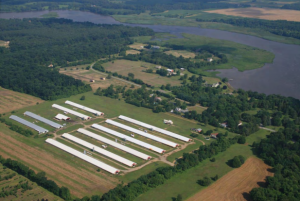
The Chesapeake Bay is overloaded with phosphorus and nitrogen, nutrients that trigger algae blooms that block sunlight and rob Bay waters of the oxygen needed to sustain a healthy ecosystem. EPA and states that share the Bay watershed have agreed to restrict discharges from agricultural, industrial and urban sources to help meet Bay water quality goals by 2025. The U.S. Environmental Protection Agency’s Chesapeake Bay Program estimates that agricultural sources accounted for 57% of the phosphorus and 42% of the nitrogen discharged to Bay waters in 2013, more than any other sector.1 Not surprisingly, farm runoff contributes the largest share of nutrients to the tidal rivers that meander through Maryland’s Eastern Shore, which are located near the heart of the state’s poultry industry. Agriculture is the source of 60 to 73% of the nitrogen and 68 to 84% of the phosphorus in Eastern Shore watersheds, which include the Chester, Choptank, Transquaking, Nanticoke, Sassafras, Manokin, Pocomoke and Wicomico rivers.
These watersheds help replenish the Bay, provide critical habitat for fish and other wildlife, and are an invaluable recreational resource for those who visit or live on the Eastern Shore. They are also surrounded by 1,339 chicken farms that sent over 500 million broilers to market in 2012, according to the U.S. Department of Agriculture, while generating over 1 billion pounds of manure containing an estimated 30.2 million pounds of phosphate. A thousand broiler chickens create about a ton of phosphorus-rich manure per year, which is then typically spread on cropland or pasture as fertilizer. Because the lower Eastern shore is already saturated with phosphorus, the amount that cannot be absorbed by soil or plants finds its way to the Bay through surface runoff or the discharge from groundwater underneath fields to nearby creeks.


